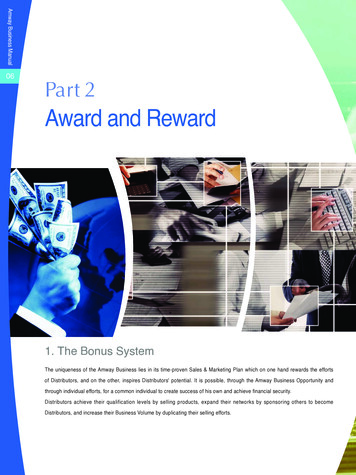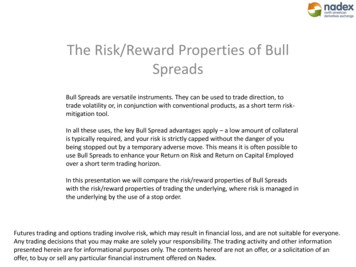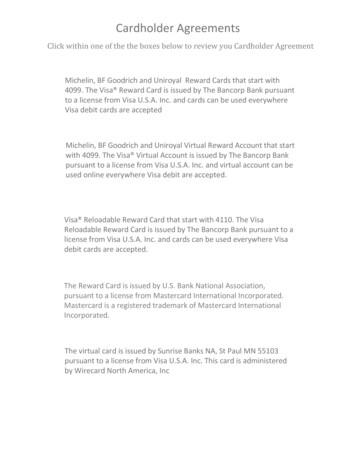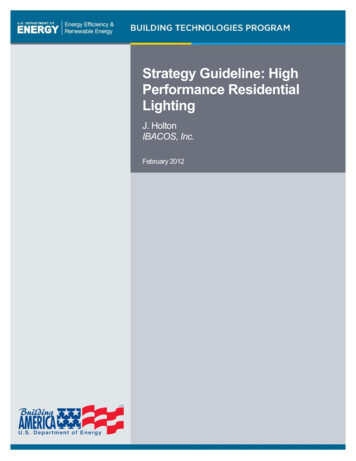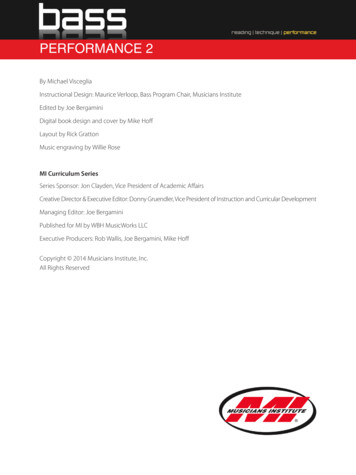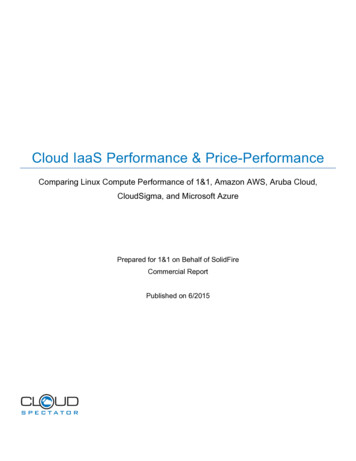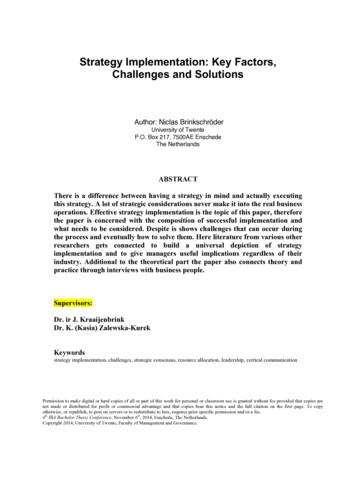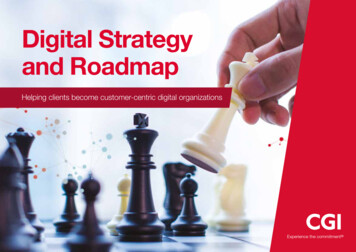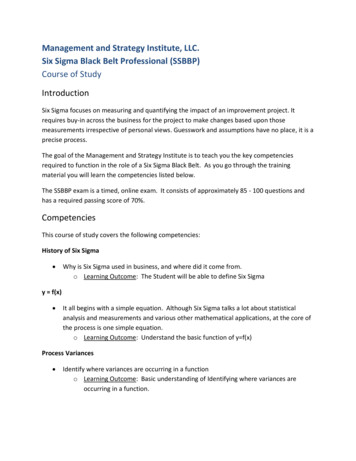
Transcription
International Journal of Business, Humanities and TechnologyVol. 2 No. 1; January 2012The Reward Strategy and Performance Measurement (Evidence from MalaysianInsurance Companies)Ong Tze San and Yip Mei TheenFaculty of Economics and ManagementUniversity Putra MalaysiaMalaysiaTeh Boon HengLecturerFaculty of ManagementMultimedia University MalaysiaMalaysiaAbstractPurpose -- The purpose of this paper is to contribute to the body of knowledge in the area of reward systems,particularly the total reward framework. The reward framework determined serve as the principal guideline forthe small and medium enterprise in Malaysia.Design/methodology/approach -- The paper used an intensive case study of two selected insurance companies,known as Agency A and Company B. The two companies are different in terms of their size and capital.Findings -- The findings suggest that the use of financial and objective measures are the main concern indesigning the reward systems of the organization, companies are gradually incorporated non-financial measuresin their reward systems. Other remarkable findings include identical rewards are tied to different working naturewhich is found to be deviate from the normal norms.Research limitation/implications – The reward framework identified can be used as guideline for the small andmedium enterprises in Malaysia to further understand the function of reward system, thus design and implementtheir unique and attractive reward system.Originality/value – The paper shows that rewards lead to increase in both financial and non-financialperformance which will also enhance companies’ reputation, as well as increase the recruitment possibility wheremore manpower will make a stronger team. Effective rewards mechanism will shift from fulfilling employees’basic requirement to self-actualization as they are growing with the business.Article Type: Research paperKeyword(s): Reward strategy; Total Rewards Approach; Financial PerformanceINTRODUCTIONRewards is one of the important elements to motivate employees for contributing their best effort to generateinnovation ideas that lead to better business functionality and further improvise company performance bothfinancially and non-financially. Edward and Christopher (2006) have mentioned that people do not automaticallycome to work, continue to work, or work hard for an organization. We see that people need motivation to shareand fulfill the organization’s vision. Undoubtedly, reward strategy and systems are the mechanisms that make thishappen. Since 1980s, many research and studies have been done on the reward aspect in other countries especiallyin the United State and China (Edward and Christopher, 2006; Lee and Wong, 2006; Paul, 1981; Sarin andMahajan, 2001 and etc). However, few researchers in Malaysia have started to focus their study in this area. DoMalaysian companies agree that a reward is able to motivate its employees and hence lead to an increase in thecompany’s financial performance? What kind of strategy that is often being used in Malaysia’s companies? Sincethe reward strategy applied at different countries may vary due to the informal factors such as cultural insight oremployee’s preference, and may pose different outcome to the organization, it is essential for us to understand thereward strategy in the Malaysia context.211
Centre for Promoting Ideas, USAwww.ijbhtnet.comThe objective of exploring the reward strategy and relationship justification on reward system with financialperformance will then address the contribution of reward strategy in supplementing financial performance of anorganization and provide an informed view to others company executives on the reward strategy that can beimplied on.LITERATURE REVIEWThe practicing of Reward StrategyAccording to Armstrong (2000, pg.232), reward strategy is the policy that provides specific directions for theorganization to develop and design programmes which will ensure its rewards the performance outcomessupporting the achievement of its business goals. Vicki (1994) agreed that reward strategy gives specific directionto how the company will design its individual reward programs. As defined by Gomez-Mejia and Balkin (1992)in Armstrong (2000, pg.232), a reward strategy is:The deliberate utilization of the pay system as an essential integrating mechanism throughwhich the efforts of various sub-units and individuals are directed toward the achievement ofan organization’s strategic objectives.Numerous studies have shown positive results on the effect of reward structures on the performance measure.Sarin and Mahajan (2001) came up with a few implications on how the rewards structure influence on the teamperformance. The performance dimensions which are not affected uniformly by the reward structure shouldencourage the practitioners to reexamine some currently accepted theories and practices. This indicates thatsuitable reward strategy development is indeed very important to each and every organization. Meanwhile, Leeand Wong (2006) have found that reward does have an impact on the company’s innovation performance. Inaddition, Paul (1981) suggests that a reward strategy can point out the significant areas of an organization, andguiding its future orientation.Nowadays, a different and more flexible approach is needed in meeting changing lifestyles as well as the needs oftoday's young professionals (The Star, 2010). Recent trend as reported by Woods (2010) shows that the financialsector has changed the mix of pay, switches their reward focus from short-term incentive schemes to long-termincentives scheme, according to a global survey by Mercer. They are changing to focus more on balanced, riskadjusted performance measurement and deferral of bonus payouts over a multi-year timeframe. Also, according toa study released by Hay Group (2010), a global management consulting firm based in Philadelphia, the globalrecession and other macroeconomic trends in the global economy is prompting the businesses to change theirreward strategies.The Total reward approachTotal reward could be used to manage and motivate people by thoroughly understanding the relative significanceplaced on the various aspects of the reward proposition and applied the well-designed total reward strategyeffectively. According to Armstrong and Stephens, (2006, pg.7) total reward is the combination of both thefinancial and non-financial rewards made available to the employees. As defined by Manus and Graham inArmstrong and Stephens (2006, pg.13), total reward includes all type of rewards, direct and indirect, as well asintrinsic and extrinsic. Each aspect of rewards is being linked together as an integrated and rational whole.Meanwhile, WorldatWork (2007), a global human resources association in US with main focuses oncompensation, benefits, work-life and integrated total rewards, has define total rewards as all of the tools availableto the employer that may be used to attract, motivate and retain talented employees. It includes everything that theemployee perceives to be of value in their employment relationship.Designing a total reward strategy that will ensure a well-integrated and cost-effective approach to compensateemployees is possible. The system built will ensure that the variable compensation costs is predictable andcontrollable, as well as employees have clear understanding about the connections between their efforts,productivity, and performance results, and between company results and their reward opportunities (Vicki, 1994).The theory basis of total reward includes Maslow’s need hierarchy theory, Alderfer’s ERG theory; two-factortheory put forward by divides job-related factors into hygiene factors and motivators, Expectancy Theory, as wellas Adams’ Equity Theory. The review of these related literature shows that when total reward strategy is to beadopted, it must assure that employees’ diverse needs must be well considered, and all these theory will help theorganization reach its performance expectation (Jiang, Xiao, Qi, Xiao, 2009).212
International Journal of Business, Humanities and TechnologyVol. 2 No. 1; January 2012Various subsets of total reward strategy have been suggested as to suit the growing needs of the reward pattern.Jiang et al. (2009) have reviewed on several studies regarding the principal elements of total rewards; such asoutlined by Francis and Fernandes (1998) where their structure includes basic salary, variable pay, pensionbenefits, death-in-service benefits, long-term disability benefits, private medical insurance, vacation entitlement,company car schemes, share schemes, mortgage subsidies and others, as well as Patricia and Jay (2000 and 2003)components that include individual growth, compelling future, total pay and positive workplaces. Besides that,Lyons and Ben-Ora (2002) have define total reward strategy to include the following, that are base salary,variable pay (short-term and long-term incentives), other compensation, perquisites, benefits and performancemanagement. Moreover, training, career development, coaching and other employee-related policies shall beincluded. They pointed out that total reward strategy can be the holistic framework of pay for performance as itcovers all aspect of reward strategy.In a more recent development of total reward strategy, Chen and Hsieh (2006) have shown the trend of rewardmethod is changing from a simplex to a multiplex context due to the rapidly changing environment. The adoptionof total reward system will help to retain the best worker and ensure the organization stay in a best positioned forfuture success. Other than that, WorldatWork (2007), the total rewards association depicts total rewards into fiveelements that are compensation, benefit, work-life, performance and recognition, and development and careeropportunities; they also take into concern of the external influences on a business, such as legal or regulatoryissues, cultural influences and practices, and competition (see Exhibit 1). This is supported by White (2005)literature which pointed out that a global reward approach required balance degree of global consistency with thelocal practice and culture to ensure the success implementation of rewards programs both globally and locally.Exhibit 2 summarized on the total reward strategy and its components discussed above.Reward, Motivation and PerformanceResearchers have been exploring the relationship between reward and performance (Sarin and Mahajan 2001; Leeand Wong, 2006; Paul, 1981). They are questioning whether the reward strategy applied has positive or negativeeffects on an organizational performance either financially or non-financially. Performance measurement is oneof the strategic management components which evaluate the results of resources utilization, as well asimprovement in the organization performance. Non-financial measures on key business process such as productquality (Lakhal and Pasin, 2008), customer relationship management (Roger, 1996) and employee-orientedmeasures (Christina and Gursoy, 2009) are indirect leading factors of financial performance. The working paperby Hughes, Simpson, and Padmore (2007) shows there are inherent limitations in using only financial ratioanalysis to assess small and medium sized company performance.Yet, Hashim (2000) make known that many literatures are suggesting financial profitability and growth is themost common measures of organizational performance; it is such as profit margin, return on assets, return onequity and return on sales (Robinson, 1982; Galbarith and Schendel, 1983), as well as the financial measurespreferred by Malaysian manufacturing firms were sales, sales growth, net profit and gross profit (Kassim, 1989).Despite the extensive literature favoring the use of non-financial measures such as Total Quality Management(TQM), Business Process Reengineering (BPR) and the Balanced Scorecard (BSC), Ruzita (2007) has indicatethat financial measures such as sales revenue, operating income, sales growth, manufacturing costs, and cashflows are still important and receive more weight in the performance measurement systems in Malaysia context.Armstrong (2006) further mentioned that reward practice will enhance motivation, commitment, increase jobengagement and develop discretionary behavior. He further define motivation process as course of action thatencourage the employees to establish goal, take action, and attain goal – a valued reward that satisfies theirparticular needs. The goal, in organization aspect, can be defined as desirable performance both financially andnon-financially such as increase in profit and increase in product quality. Exhibit 3 summarized a few studies onhow the reward system can motivate performance. Consequently, a research framework as follow (figure 1) isbeing developed to assess in depth the reward strategy applied by the selected companies of the practical industryin relation to performance.213
Centre for Promoting Ideas, USAwww.ijbhtnet.comTYPE OF REWARDSindividual growthcompelling futuretotal payMOTIVATIONpositive ceperformance elopment andcareer opportunitiesFigure 1: Research FrameworkMETHODOLOGYA case study approach had been selected to assess in depth the reward strategy applied in relation to theperformance of the organization. Two organizations are selected are in the insurance business which placed greatemphasize in sales and customer relationship management activities, serving the major roles in the service industryin Malaysia. This sector has been identified as an engine of growth for Malaysia economic in the future trend.National Product and Expenditure Accounts Second Quarter (2010) has revealed that the Services Sector inMalaysia had accounted for 56.9 per cent to GDP, and expanded by 7.3 per cent in the second quarter of 2010.Indeed, the finance and insurance sub-sector bolsters further by 8.4 per cent showing a higher demand for banklending and life insurance in the country. Hence, foreseeing the insurance business is growing fast and becomemore competitive in the trade environment, this study can give a better view on the influence of reward systemtowards motivation and organization performance.RESEARCH FINDINGS AND ANALYSISThe respondents identity will remain confidential as per request due to reason that reveal of identity may causeany unfavorable consequences. The smaller size company with limited capital entity will be make known asAgency A while the bigger size company with larger capital amount will be disclosed as Company B.Agency A is a private limited company specializing in financial planning and consultation established in Malaysiain year 2004. They had agglomerated the world of banking, law, taxation, and investment, partnering with GreatEastern Life Assurance (Malaysia) Berhad. On the other hand, Company B is Hong Leong Assurance (HLA)Berhad, one of the Malaysia's leading domestic brands for financial planning and protection solutions,specializing in Life Insurance products and services. HLA provide their services through a large network ofbranches, agents and brokers throughout the country.Reward StrategyThere are similarities in the reward strategy and type of rewards being offered by both Agency A and Company B.As in Morris and Maloney study (2005), best practice policies applied to reward system are universal. Since thecore policy does not change despite of different organization’s strategic forces, this proposes that similar rewardsystems will exist across organizations and industries. From the data collected, summarization on the differentstrategy implemented by both of the respondent is being compared as follow:214
International Journal of Business, Humanities and TechnologyVol. 2 No. 1; January 2012Table 1: Comparison of strategy implemented by respondentsReward StrategyLong-term IncentivesTotal PayEmployee Trainingand DevelopmentIndividual growthBenefitsPerformance andRecognitionDevelopment andcareer opportunitiesPositive WorkplaceWork-lifeAgency APerformance-based deferred benefitPerformance-based payProduction bonusPersistency bonusRoutine training classOpen discussion on career pathSelf-development coursesFestive incentivesVacation incentivesSport day and movie dayCompany’s awardIndustry’s awardOpportunity to hold managementpositionTwo to three years to be promoted tomanager levelSpatial office with sense of relaxationat homeSelf-employedFlexible working hours RegularmeetingCompany BPerformance-based retirement benefitsPerformance-based payPersistency bonusGroup sales bonus Recruitment bonusRoutine training classSpecial training programmeMotivation seminarNoneFestive incentivesVacation incentivesNon-monetary incentiveCompany’s awardIndustry’s awardHLA 1-3-5 Model-1st year: Agent-3rd year: Unit Manager-5th year: Agency ManagerComfortable workplaceCasual dress codeSelf-employedDiscipline working hoursRegular meeting and case study trainingThe implementation of reward system is essential for achieving company’s goals regardless of the organizationsize or their role and position in the industry. From an agency unit to the company level, reward strategy shouldbe the core policy to motivate the agents to achieve better performance and to accomplish business objective.Nevertheless, the choice of reward strategy will then depend on the type of the organization, its size, the extent ofthe individual role in selling process and the product and services its offer to the customer. (Paul and Peter, 2006)Also, in Paul and Peter’s (2006, pg24) conclusion, the nature of sales is one of the main reasons why rewardshave to be used to ensure sales staff to act in the best interest of the business.Effect of Reward Strategy on Recruitment and Financial PerformanceAgency A’s respondent pointed out that rewards will positively affect the agency performance both financiallyand non-financially. Financially, an employee achieves better sales volume in order to receive the rewards offered.The following (Table 2) shows the comparison of sales volume of the month with reward strategy and the monthwithout for a particular employee on different position level. Non-financially, enjoyable and energize team-spiritin a positive workplace will result in outstanding performance. The agency is able to achieve their desired targetand experience faster growing prospect. Other than that, rewards lead to increase in both financial and nonfinancial performance which will also enhance their agency’s reputation, as well as increase the recruitmentpossibility where more manpower will make a stronger team.Table 2: Comparison of sales volume of the month with reward strategy and the month withoutPosition/Level(Experience)Rookie Agent( 12 months)Agent(1-2 years)Carrier Agent( 3 years)Unit Sales ManagerBy Group(Team members)By AgencyNameSales Volume inOctober 2010 (RM)SalesVolumeinNovember 2010 8,345.10894,811.00NgLimWong215
Centre for Promoting Ideas, USAwww.ijbhtnet.comMeanwhile, Company B’s respondent also pointed out that rewards will give positive impact towards theirorganization performance. Non-financially, the rewarding career path is able to attract young talents to join thecompany. This is important as the company is in the progress of developing and expanding its market. Youngtalents who always aim for fruitful rewards will give in their best effort to perform for the pays, incentives,benefits and bonuses. They believe that an energize team well supported by positive workplace environment willbe able to generate outstanding performance in accordance to the company’s mission and vision. Hence, thecompany will then achieve their desired growing prospect. Rewards not only can enhance their agent’s confidencetoward the company’s future development,
benefits, death-in-service benefits, long-term disability benefits, private medical insurance, vacation entitlement, company car schemes, share schemes, mortgage subsidies and others, as well as Patricia and Jay (2000 and 2003) components that include individual growth, compelling
